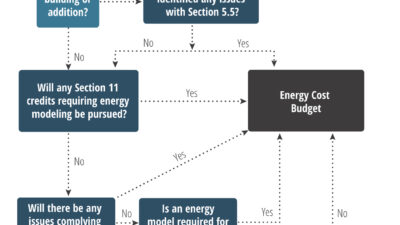The owners and managers of manufacturing facilities are often heavily focused on managing the costs of process and production. They’re thinking about lean manufacturing and “six sigma.” And while energy efficiency—and cost—is a concern, they tend to defer to others on the issue.
By some accounts, industrial applications account for 90% of all cogeneration systems. Why is cogen particularly attractive for industrial facilities? “Industrial facilities, manufacturing and processing, are excellent candidates for both topping cycle and bottoming cycle cogeneration,” says Syed Peeran, P.E., Camp Dresser & McKee, Cambridge, Mass., “because they require significant amounts of process heat in addition to electric power. In many facilities, the thermal needs constitute 65% to 90% of the total energy consumption. In addition, waste gases in most manufacturing and processing plants are at a high temperature, typically 2,000°F, ideal for use in bottoming cycle cogeneration. Waste-heat recovery reduces the energy consumption.”
An explanation of the different types of cogen plants is in order. In a nutshell, the typical cogen system consists of an engine or turbine and a generator. Facilities with cogeneration systems use them to produce their own electricity and use the unused excess (waste) heat for process steam, hot water heating, space heating and other thermal needs. They may also use excess process heat to produce steam for electricity production.
There are two main types of cogen: topping cycle plants and bottoming cycle plants. The former generates electricity or mechanical power first. There are four types of topping cycle plants:
-
Gas-turbine systems, which use a natural-gas turbine to drive a generator. Exhaust gas is sent to a heat recovery boiler that makes process steam and heat.
-
Natural gas, diesel, wood, biogas or some other fuel is the prime power, where hot water from an engine cooling system goes to a heat-recovery boiler and is converted to steam and heat.
-
Combine-cycle processes, where a gas turbine is used to create electrical or mechanical power, and the exhaust provides process heat or goes to a heat-recovery boiler.
-
Steam turbine systems, in which high-pressure steam is produced that then passes through a steam turbine.
Bottoming cycle plants, on the other hand, are much less common than topping cycle plants and are more common in heavy industries that rely on high-temperature furnaces. A boiler captures waste heat from the manufacturing process and delivers it to a steam turbine to produce electricity.
“In a topping cycle plant, the primary generation is electric power,” explains Peeran, “whether created by on-site diesel generators, steam-turbine driven generators or fuel cells. The heat produced is used for the thermal needs of the facility, such as process heat, area heat or heating hot water.
On the other hand, explains Peeran, in bottoming cycle cogen, the process waste heat or waste byproducts are used to generate electricity, which offsets the demand for electrical power from the electric utility.
“One example I can think of is a wastewater treatment plant in Boston,” he says. “The digester gases are used to generate steam and run a steam turbine to generate electric power. The treated wastewater is passed through a water turbine before letting out in the outfall tunnel. The water turbines drive an electric generator to reclaim the hydraulic energy, a good example of bottoming cycle cogeneration.”
The suitability of a prime-mover technology is actually project-specific, explains Peeran: “Fuel cells are well-suited for topping cycle cogeneration because of their high efficiency.” Combustion turbines can use digester gases, byproducts in a wastewater treatment plant. Therefore, they can be used in a bottoming cycle cogeneration, he says. But whatever the system configuration, the real benefit of cogen in industrial facilities is the ability to reduce the energy demand from the utility (electric or gas). In order to maximize this benefit, the plant should be run at full load. At times of light load—at night or during plant shutdown—energy can be sent back to the utility.
Cogen isn’t exactly a new technology. Using gas turbines together with heat recovery steam generators (HRSGs) has been around for the better part of four decades in certain industries, especially in the sub 15-MW range—wherever electricity is expensive and gas prices are low. And there’s the rub. Until recently, natural gas has usually been cheaper than electricity, but with gas prices skyrocketing, this may have a definite impact on natural-gas fired cogen in the foreseeable future.
“We’ve been involved in studies for cogen and peak shaving for industrial facilities since the oil embargo days of the ’70s,” says Phil Granitz, P.E., with Detroit-based Harley Ellis Devereaux. “In fact, last year we did a study for a facility that already had cogen equipment, but given current prices for natural gas, it can’t run cost-effectively. In Michigan today, the differential between natural gas and electricity doesn’t justify specifying cogen.”
However, Granitz points out, this isn’t necessarily true everywhere, with the notable exception being California. “Gas is still inexpensive in California—relative to electricity—so we are considering cogen for a campus facility there.”
The energy pricing situation in California is confirmed by other firms working on projects in that state. “The fact that natural gas prices are competitive in California has to do with the lasting effects of the California energy crisis, which has continued to keep electrical prices high,” says Scott Clark, P.E., Carter & Burgess, Fort Worth, Texas. But elsewhere, in their feasibility studies for energy savings and peak shaving at industrial facilities, engineers are looking seriously at alternatives to natural gas as a prime mover for cogen—and at other types of systems, most notably thermal storage.
Alternatives to natural gas
“We have a couple of industrial cogen projects going right now for agricultural producer/processors. One of these uses landfill gas,” says Clark. The typical technology for this type of system is a fluidized bed boiler that burners the waste stream. It creates steam that can be used as process steam, but the remainder can be used to generate power.
“Of course, there are still places where gas turbine technology is preferable—usual where a facility owner doesn’t have the material handling capabilities for biomass fuels or, it’s a problem with environmental issues,” he says. “But we’re doing lots of feasibility studies for biofuel-driven cogen. When the price of natural gas gets up to $7.50 or $8.00 per MMBTU, the economics start to look good for biomass fuel.”
A look at recent trends in natural gas prices suggest that they are pretty close to where they need to be to justify biomass. For April, natural gas prices closed at $7.233 per MMBTU. Futures for May and June are at $7.06 per MMBTU and $7.29 per MMBTU respectively. The price is approximately 1.23% lower than this time last year. However, the futures are higher than 2005 for the forward months of the contract which is causing 12 month fixed prices to be substantially higher than a year ago.
Energy prices have become more volatile, to say the least, which is why most manufacturers generally prefer to turn the job of energy management over to energy service companies (ESCOs) and lock into long-term contracts. But many point to biomass as an alternative worth investigating. “With the current woes in the automotive industry—and lack of capital—our industrial clients are paying less attention to introducing cogen these days,” says Bob Stevenson, senior vice president with Ghafari, Dearborn, Mich. “But I believe there is a BMW plant in Spartansburg, S.C. that is using landfill methane.”
“We’ve been involved in microturbine-driven cogen for wastewater. This makes sense because of the methane byproduct of wastewater treatment,” says Mario Vecchiarello, P.E., vice president, Camp Dresser McKee, Cambridge, Mass. “There are issues involved with this. For instance, one might have to compress the gas to get it up to sufficient pressure.”
And there are other issues as well. “Biogas is a possibility,” says Stevenson, “but there are environmental issues with these gases. They can be very dirty and need to be cleaned up.”
There are definitely environmental issues to consider for the consulting engineer who undertakes a cogen feasibility study. New cogeneration plants are subject to an Environmental Protection Agency (EPA) permit process and must meet National Ambient Air Quality Standards (NAAQS). Many states have stricter regulations than the EPA, which can add significantly to the initial cost of cogen facilities in urban areas.
“The environmental issues with cogen tend to be very site-specific. For example, at some locations, the need for pollution-control equipment can add significantly to the cost of cogen equipment and hence, it’s first-cost viability,” says Carter & Burgess’ Clark. “But if pollution-control equipment is required for the primary industrial or commercial process anyway, then cogen can be economical. We have an environmental air permitting group that we work in concert with on these types of projects. Specialized equipment will often need to be added to a plant to prevent or reduce emissions.”
But keep in mind that the many types of cogeneration aren’t the only players in the energy savings game. And in fact, for several industrial facilities, thermal energy storage (TES) technology has proven the winner, both in terms of first cost and long-term costs—especially in existing facilities where all the right factors come together.
Other methods
One option for peak shaving has been to adapt existing equipment in a facility to this purpose. “A couple of years ago, we installed thermal storage in an engine plant using existing fire water tanks,” says Stevenson. “That kind of peak shaving make sense, because you can put in a thermocline type of system. There are insurance issues, and for new construction, a new fire water tank might be too expensive, but in an existing facility that already has the storage tank, this works quite well.”
“We’ve done about 20 facilities with TES,” says Clark. “As for adapting an existing fire water tank to TES purposes, one has to find just the right operation. Even if a facility has a fire water tank, that doesn’t mean it’s going to be big enough.”
Granitz with Harley Ellis Devereaux agrees that this is an option worth exploring but adds the caveat: “Thermal storage is always a possibility, but you have to have a load that you can satisfy that way. One has to find the ideal situation, where the existing fire water tank is the right size and ideally located.”
Best practices
So, what types of industrial facilities work best for cogen? All the experts consulted tend to agree on the following:
Cogen is most viable in energy-intensive industries, including the chemical, refining, forest products, food and pharmaceutical sectors. Abandoned industrial sites, or brownfields, are also suitable for cogen systems. Fabrication plants and foundries are good candidates for cogen, as are industrial parks, manufacturing plants, paper and pulp, printing companies, processing plants, steel manufacturing, warehouses, waste treatment facilities and wineries.
But there are obstacles to on-site cogen in the industrial sector including the following:
-
High electric utility backup power costs, onerous grid interconnection requirements, and deferral rates;
-
Local environmental regulations that do not recognize the offsetting plant boiler and central station generation emissions;
-
Unfavorable depreciation tax treatment core investment requiring quick payback;
-
High costs for equipment, installation, environmental compliance and maintenance for smaller on-site generation systems.
No matter which prime mover technology is used, all cogen projects must begin with a careful evaluation of a facility’s load profiles—both thermal and electric—including daily, weekly and seasonal variations. For a retrofit project, one might need to look at a facility’s log books and utility records for two or more years to establish seasonal load profiles.
And this brings us full circle to the observation made at the beginning: Most industrial facility owners want to focus on the manufacturing and leave the facility energy concerns to others.
“Most of the manufacturers go to ESCOs to take care of their energy needs,” says Granitz. “They want to focus on their core business, not on energy supplies and infrastructure.”
Clark agrees. “A lot of manufacturing facilities are looking to ESCOs for their energy needs. They are unbundling energy producers, and someone like us helps suppliers develop a load profile and size the system,” he says.
“Typically, industrial operations have an in-house energy management group that can go a long way toward determining their needs but can’t really do a detailed feasibility study,” says Clark. “So, they need to come to consultants like us.”
Gas Turbines Drive a Cat Plant
Three combustion turbines provide power for two Caterpillar plants in Illinois. A 45-MW cogeneration plant in Mossville provides electricity, steam, heat and chilled water service to Caterpillar’s Mossville campus while also producing electricity for the manufacturer’s Mapleton Foundry.
The combustion turbines, manufactured by Solar Turbines, burn natural gas to drive three generators, each producing 12.2 MW of electricity. In addition to the 45 MW of electricity, the plant can provide up to 410,000 lbs. of steam per hr. and 7,200 tons per hr. of chiller capacity.
The chiller plant includes two steam turbine generators rated at 8.9 MW, a York natural-gas engine-driven chiller, powered by a Cat engine and two York electric chillers. Heat from the turbines’ exhaust is run through the steam generators to turn water into steam. Caterpillar uses the steam in the winter for heating and manufacturing processes. In the summer, the steam runs through the absorption chillers to provide chilled water to cool the factory building.
“The benefits of this collaboration extend far beyond our original expectations. With this state-of-the-art technology, we have lowered utility costs for steam and electricity for an overall operational cost reduction,” said Dan Murphy, vice president of Caterpillar’s Performance Engine Products Division. “At the same time, we have improved working conditions, reliability and employee satisfaction.”
The plant has actually been running for quite some time. Caterpillar reached an energy service agreement with CILCO, an AES company, in December 1999 that resulted in the construction of the power generating facility. Construction of the plant began in July 2000, production of steam and electricity began in May 2001, and the plant began commercial service in Sept. 2001.
Wastewater Makes the Perfect Gas
The Eastern Municipal Water District in California is always exploring alternative energy sources to improve energy efficiency and reduce costs.
One EMWD project involved a digester mixing upgrade at the Moreno Valley Regional Water Reclamation Facility to increase the production of digester gas, which results from the wastewater treatment process and can be used in place of electricity or natural gas to power equipment.
EMWD also uses nine 60-kW microturbines to reduce electrical demand at its headquarters. Four turbines were recently added (bringing the total to 540 kW), and a project was completed to capture the waste heat from the microturbines to operate an absorption air-conditioning chiller.
A $113,000 incentive grant from Southern California Gas Company was used to help cover installation costs for the microturbines. EMWD has also applied for and received confirmed funding for over $500,000 under Southern California Edison’s “Savings-by-Design” program to install energy-efficient equipment at new operational facilities.



